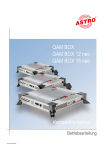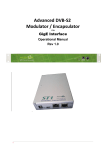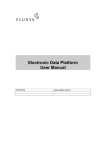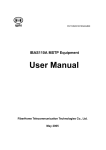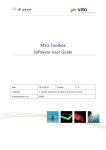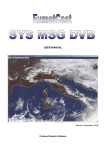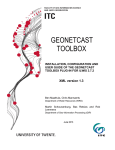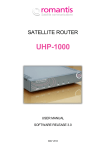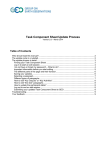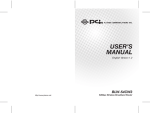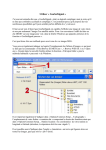Download SR1 User Manual
Transcript
Advanced DVB-S2 Receiver With GigE Interface Operational Manual Rev 1.9 i Copyright © 2011 Ayecka Communication Systems Ltd . All rights reserved. Ayecka technical documentation and the product(s) described herein are protected by one or more U.S. copyrights, patents, foreign patents, or pending applications. No part of this publication may be reproduced or transmitted into any human or computer language in any form or by any means, stored in a retrieval system, transmitted, redistributed, translated or disclosed to third parties, or de-compiled in any way including, but not limited to, photocopy, photograph, electronic, mechanical, magnetic or manual without the expressed written permission of Ayecka Communication Systems Ltd ., or its licensors, if any. All copies, so authorized, shall contain a full copy of this copyright notice. Ayecka are licensed products. The product licenses convey the right to use only those specific products, components, modules, features and/or functions specified in the license agreement or contract. This publication may mention or reference products, components, modules, features and/or functions that are not part of a particular license agreement. The customer is not entitled to the receipt of, or use of, any other products, components, modules, features and/or functions that may be referenced in any documentation provided to customer unless additional license fees are paid and an appropriate license agreement is duly executed. Ayecka Communication Systems Ltd ’s obligations with respect to its products and services are governed solely by the agreements under which they are provided. This publication is furnished for informational use only and should not be construed as a commitment by Ayecka Communication Systems Ltd . The information could include technical inaccuracies or typographical errors. Every effort has been made to make this publication as complete and accurate as possible, but it is provided “as is” without warranty of any kind either expressed or implied, including, but not limited to, the implied warranties of merchantability, fitness for a particular purpose, or non-infringement. Ayecka Communication Systems Ltd may make improvements and/or changes in the program(s), product(s), and/or applications described in this publication at any time without notice. Due to continuous development of Ayecka Communication Systems Ltd . products, information published in this document may become obsolete. Third-party products, services, or company names referenced in this document may be trademarked or copyrighted by their respective owners, and are for identification purposes only. This publication is protected by federal copyright law. No part of this publication may be copied or distributed, transmitted, transcribed, stored in a retrieval system, or translated into any human or computer language in any form or by any means (electronic, mechanical, magnetic, manual, or otherwise); or disclosed to third parties without the express written permission of Ayecka communication systems LTD. ii Advanced DVB-S2 Receiver Operation Manual Table of Contents About This Document ........................................................................................ 2 1.1 Target Audience ....................................................................................................................... 2 1.2 Purpose and Applicability ......................................................................................................... 2 1.3 Applicable ................................................................................................................................. 2 1.3.1.1 Software – SR1 1.05b232 and above ....................................................................... 2 1.3.1.2 Board version 2.00 and above ................................................................................... 2 1.3.1.3 Boot Loader - 1.01b14 and above ............................................................................. 2 1.3.1.4 Firmware .................................................................................................................... 2 1.4 Technical Support Contact Information .................................................................................... 2 1.5 Eumetcast ................................................................................................................................. 2 SR1 Hardware ..................................................................................................... 4 2.1 SR1 Hardware Interfaces ......................................................................................................... 4 2.2 Internal GigE Switch ................................................................................................................. 4 2.3 Application board ...................................................................................................................... 5 2.4 ASI ............................................................................................................................................ 5 Quick Installation Guide .................................................................................... 7 SR1 Functionality ............................................................................................... 9 4.1 SR1 Integration in Satellite over IP Networks .......................................................................... 9 4.2 SR1 Block Diagram ................................................................................................................ 10 4.3 SR1 Receivers Management .................................................................................................. 11 4.4 SR1 Packets forwarding ......................................................................................................... 11 4.5 SR1 with VCM signals ............................................................................................................ 12 4.6 SR1 SNMP MIB ...................................................................................................................... 12 SR1 Installation ................................................................................................ 14 5.1 Powering Up the SR1 ............................................................................................................. 14 5.2 Front Panel ............................................................................................................................. 14 5.3 Back Panel .............................................................................................................................. 16 5.4 ...................................................................................................................................................... 17 iii 5.5 Installation Procedure ............................................................................................................. 18 5.6 Power UP ................................................................................................................................ 18 5.7 Configuration .......................................................................................................................... 18 5.8 Cables Connection ................................................................................................................. 18 SR1 Configuration and Management.............................................................. 20 6.1 Serial Interface........................................................................................................................ 20 6.2 Telnet Interface ....................................................................................................................... 20 SR1 User Interface ........................................................................................... 22 Advanced DVB-S2 Receiver Operation Manual 7.1 General ................................................................................................................................... 22 7.2 Powering Up ........................................................................................................................... 22 7.3 Main Menu .............................................................................................................................. 23 7.4 Configuration Menu ................................................................................................................ 24 7.4.1 Number of Transport Filters ............................................................................................ 24 7.4.2 RX Data Stream Mode .................................................................................................... 24 7.4.3 RX Channel Operation Mode .......................................................................................... 24 7.4.4 RX Channel Switching ..................................................................................................... 25 7.4.5 RX Channel Switch Mode ............................................................................................... 26 7.4.6 Configuration RX Channel Switch Period ....................................................................... 26 7.4.7 Select Active RX Channel ............................................................................................... 26 7.4.8 RX Channel Configuration Menu ..................................................................................... 26 7.4.8.1 7.4.8.1.1 7.4.8.2 7.4.8.2.1 RX Channel Configuration Sets Management ......................................................... 27 RX Channel Configuration Sets Management: Profile Switch Period .................. 27 Active Configuration Set ........................................................................................... 28 RX Channel Filters Table Menu ........................................................................... 30 7.4.8.2.1.1 RX Channel Transport Filter Record Configuration Menu ............................. 30 7.5 Status Menu ............................................................................................................................ 32 7.6 Network Menu ......................................................................................................................... 34 7.6.1 ARP Management ........................................................................................................... 35 7.6.2 ARP Configuration ........................................................................................................... 35 7.6.3 ARP Cache Table ............................................................................................................ 36 7.7 System Menu .......................................................................................................................... 37 7.7.1 Warm reset ...................................................................................................................... 38 7.7.2 Cold reset ........................................................................................................................ 38 7.7.3 Restore factory Defaults .................................................................................................. 38 7.7.4 Telnet ............................................................................................................................... 38 7.7.4.1 Username ................................................................................................................. 38 7.7.4.2 Password.................................................................................................................. 38 7.7.4.3 Timeout .................................................................................................................... 38 7.7.5 NTP Server IP Address ................................................................................................... 38 7.7.6 SNMP Trap Server IP Address ....................................................................................... 38 7.7.7 SNMP Read Community ................................................................................................. 38 7.7.8 SNMP Write Community ................................................................................................. 38 7.7.9 Events Configuration menu ............................................................................................. 39 7.7.9.1 System Response Configuration ............................................................................. 39 7.7.10 FPGA Upgrade Menu ...................................................................................................... 39 7.7.11 Show Installed Versions Menu ........................................................................................ 40 The SR1 can save two FPGA images in its internal non Volatile Memory. ................................... 40 The Show Installed Versions menu includes the following: ........................................................... 40 4 Advanced DVB-S2 Receiver Operation Manual Version: The version number of the FPGA image .................................................................. 40 Image Size: The size of image in Bytes ................................................................................. 40 Valid: Indicates whether the image is valid and can be used ................................................. 40 Active: Select whether to use the image in the next Cold reboot / Power cycle. ................... 40 7.7.12 Software Upgrade Menu ................................................................................................. 40 7.7.12.1 7.7.13 Hardware Information Menu ............................................................................................ 41 7.7.14 Display Running Configuration ........................................................................................ 41 7.7.15 Menu Timeout.................................................................................................................. 41 7.7.16 Factory Settings............................................................................................................... 41 7.7.17 Bootloader Upgrade ........................................................................................................ 42 7.7.18 RX Link Margin Thresholds ............................................................................................. 42 7.7.18.1 5 Show Installed Versions Menu ................................................................................. 41 Statistics ................................................................................................................... 43 7.7.19 Show Transport Statistics ................................................................................................ 43 7.7.20 Reset Transport Statistics ............................................................................................... 43 Trouble Shooting.............................................................................................. 45 8.1 General ................................................................................................................................... 45 8.2 Power LED is Off .................................................................................................................... 45 8.3 Power LED Constantly RED ................................................................................................... 45 8.4 Lock LED is Red ..................................................................................................................... 45 8.5 LAN Interface Does Not React to Ping ................................................................................... 45 8.6 No Data Received by Default gateway ................................................................................... 46 8.7 Management Interface does not react to Telnet, SNMP and Ping ......................................... 46 8.8 No data is received by an host on the LAN ............................................................................ 46 8.9 No Multicast traffic from the Traffic interface .......................................................................... 46 8.10 No traffic form RF received on LAN .................................................................................... 46 8.11 SR1 indicates firmware version “error” ............................................................................... 46 8.12 SR1 indicates serial number 987654321 ............................................................................ 47 8.13 TFTP fails when Telnet session is active ............................................................................ 47 SR1 Specifications ........................................................................................... 50 9.1 Receiver DVB-S2 Mode ......................................................................................................... 50 9.2 Receiver RF ............................................................................................................................ 50 9.3 LNB power and Control .......................................................................................................... 50 9.4 TS Processing ........................................................................................................................ 50 9.5 Data Interface ......................................................................................................................... 51 9.6 Environmental Conditions ....................................................................................................... 51 9.7 Physical Characteristics ......................................................................................................... 51 9.8 Operating Power ..................................................................................................................... 51 9.9 Management Interface ............................................................................................................ 51 Advanced DVB-S2 Receiver Operation Manual 9.10 Control and Monitoring ........................................................................................................ 51 9.11 Configuration Parameters ................................................................................................... 52 9.12 Monitoring Parameters ........................................................................................................ 52 9.13 Maintenance........................................................................................................................ 52 9.14 Standard Compliance ......................................................................................................... 52 SR1 Serial over USB Cable ........................................................................... 54 SR1 Software and Firmware Upgrade ......................................................... 58 11.1 FPGA Image Management ................................................................................................. 58 11.2 Software Image Management ............................................................................................. 62 11.2.1 Software Image Upgrade using TFTP ............................................................................. 62 11.2.2 Software Images Upgrade with Flash Magic ................................................................... 63 11.3 BootLoader Image Management ........................................................................................ 64 Safety ............................................................................................................. 67 Release Notes ................................................................................................ 69 13.1 SW Release Notes for SW Version 1.05b232 / FPGA version 2.02b022 and UP, BootLoader 1.01b14 .......................................................................................................................... 69 13.2 Open Known Issues ............................................................................................................ 69 SR1 Integration with Other Technologies ................................................... 71 SNMP MIB ...................................................................................................... 73 6 Advanced DVB-S2 Receiver Operational Manual About this Document About this Document 7 1 Advanced DVB-S2 Receiver Operational Manual About this Document About This Document 1.1 Target Audience The target audience for this document is IP over satellite communication professionals. 1.2 Purpose and Applicability This document introduces the setup, configuration, monitoring and troubleshooting of SR1. 1.3 Applicable This document is applicable for the following SW and FW 1.3.1.1 Software – SR1 1.05b232 and above 1.3.1.2 Board version 2.00 and above 1.3.1.3 Boot Loader - 1.01b14 and above 1.3.1.4 Firmware sr1_dt_v2.2b22.afp: General MPE functionality sr1_dt_v2.2b622_prom.afp: MPE in Promiscuous mode sr1_dt_v2.2b822a_mcast_remap.afp: multicast output remap. sr1_dt_v2.2b922a_9_PID.afp: FPGA to add 9th PID for Eumetcast DVB-S For further details refer to the detailed release notes in Chapter 13. ! Note SW release upgrade may delete the current configuration. Please make sure you retrieve and save configurations form the SR1 prior to upgrade SW upgrade from 1.05b195 and below to 1.05b232 will erase current FPGA image and require TFTP of new one – It is not possible to upgrade from 1.05b195 and below to 1.05b232 over satellite link where SR1 is the receiver 1.4 Technical Support Contact Information For technical support please contact: Ayecka Communication systems LTD [email protected] 1.5 Eumetcast For Eumetcast users – please see SR1 Setup Guide in Eumetcast website 2 Advanced DVB-S2 Receiver - Operational Manual SR1 Hardware SR1 Hardware 3 Advanced DVB-S2 Receiver - Operational Manual SR1 Hardware SR1 Hardware 2.1 SR1 Hardware Interfaces The SR1 has the following interfaces: Two RF front ends GigE interface 100BaseT management Interface Serial over USB Management Interface. The SR1 can be operated with a single demodulator or with dual demodulators. When the second Demodulator is in use, both Demodulators are limited to DVB-S2 8PSK CCM 30Msps. The configuration of demodulator operation mode is supported in the terminal menu and SNMP. 2.2 Internal GigE Switch The SR1 architecture is based on an internal GigE switch. The switch has the following ports: Traffic: GigE port MGMT: Fast Port Internal CPU: RMII connection Internal FPGA: RGMII connection Application CPU: GigE interface for an optional dedicated applications CPU The use of the internal switch simplifies installations where the return channel is a Local Wireless Loop or a Satellite TX device. In network where full isolation of the management and traffic is needed, the SR1 can be set to Isolate mode that disable the internal switching between management and traffic. 4 Advanced DVB-S2 Receiver - Operational Manual SR1 Hardware 2.3 Application board The SR1 supports an option for the Application board. The Application board is a daughter board that can be added to the SR1. The Application board has a GigE interface to the internal switch. The application board can be customized according to the application requirement. For additional information please contact [email protected]. 2.4 ASI The SR1 supports an option for single ASI input and ASI output. For additional information please contact [email protected].. 5 Advanced DVB-S2 Receiver Operational Manual Quick Installation Guide 6 Advanced DVB-S2 Receiver Operational Manual Quick Installation Guide Follow the steps described in Table 1 to perform a Quick Installation of the SR1. After any change has been performed, enter 0 as many times required to return to the Main Menu. This will save the changes to the non-volatile RAM (for further details refer to Chapter 5). If an incorrect value was entered, press Esc to ignore the entry. Action Connect the USB Cable Verification Communication with SR1 Reference Chapter 10 Install Serial over USB driver and run hyper terminal Modify the management port IP address 7.6 Menu 3.1. Modify the LAN IP address 7.6 Set the IP address of default gateway 7.6 Connect the Management Ethernet cable 5.8 Connect the Traffic Ethernet cable 5.8 Verify DHCP is off Menu 3.A Verify DHCP is off Ping to the Management and Traffic interfaces to verify connection Menu 3.E 5.8 Verify other network elements are properly configured Set RF frequency 7.4.1 Menu 1.1.1.1 Set LNB Power 7.4.1 Menu 1.1.1.F Set 22Khz 7.4.1 Menu 1.1.1.H 7.5 RF Lock LED 7.4 Menu 1.1.1.E Verify RF lock Configure the MPE filter (MAC and PID) Verify traffic to LAN Verify default gateway MAC Read statistics and Wireshark 7.6 Table 1 - Quick Installation 7 Note Menu 3.G.1 Advanced DVB-S2 Receiver Operational Manual SR 1 – Functionality 8 Advanced DVB-S2 Receiver Operational Manual SR1 Functionality 4.1 SR1 Integration in Satellite over IP Networks The SR1 is designed to be integrated into IP over satellite network topologies as described in Figure 1. The Satellite dish (with LNB to receive the signal), and the IP router (which enables the SR1 to forward the IP packets) are common to all the systems. Figure 1 demonstrates a general installation scenario of the SR1. Figure 1 Typical SR1 Installation The SR1 integration process is described as follows: The SR1 RF input is connected to the LNB on the satellite dish. SR1 provides the LNB with the appropriate power and control and receives the DVB-S/S2 signal in L-Band. The only parameter the operator requires to configure is the RF L-band frequency. The SR1 automatically detects all other parameters. For a symbol rate below 1 Msps or for modulations higher then 8PSK, a manual configuration of the symbol rate may be required. The automatic channel parameters detection enables the operator to change the MODCOD of the link without the requiring to re-configure the receiver. The SR1 supports two RF inputs and can be operated either as single demodulator with two RF inputs or dual demodulators. The selection between the two Rx channels and the Rx configuration profiles can be performed manually or automatically. All the Unicast IP packets that the SR1 extracts from the satellite signal are forwarded to the router. The SR1 does not support routing functionality what’s so ever. The IP address of the default router is configured manually. The SR1 uses ARP to find the MAC address of the router. The IP address of the default router is not required to be on same subnet as the Traffic interface of the SR1. The Default router must replies to the ARP request of the SR1. SR1 supports internal ARP table of 16 entries, making it capable of serving a LAN without a router. When an MPE section has a destination IP address different to the default router, the SR1 will initiate an ARP request to learn the MAC address. If a reply is received the SR1 will keep the match in its internal ARP table. If the table reaches the 17th, address, the oldest entry will be overridden. In SR1 uses the ARP table IP address and the ARP table IP mask to determine if an incoming packet is in its subnet and implement the ARP mechanism. If the packet is not in the SR1 9 Advanced DVB-S2 Receiver Operational Manual subnet, it will be forwarded to the default gateway. By default the SR1 ARP table IP address is set to the Default Router IP Multicast traffic received is forwarded directly to the Traffic LAN and is blocked from the Management LAN The SR1 supports three management interfaces, as follows: 100BaseT interface using Telnet 100BaseT interface using SNMP. Serial over USB interface with a text based terminal application. Note Both Traffic and management ports of the SR1 are connected to the internal switch. Connecting both of them to an external switch may cause issues with functionality of both switches 4.2 SR1 Block Diagram The SR1 Block Diagram is illustrated in Figure 2 SR1 Block Diagram Figure 2 SR1 Block Diagram The SR1 structure includes the following parts: Tuner 1 and 2: Full L-Band RF front end with LNB powering and control. When SR1 operates with a single demodulator, both tuners are assigned to the demodulator and the tuners act in redundant mode. When using the SR1 in dual demodulator mode each demodulator has a single tuner. DVB-S2 Demodulator: The demodulator can be configured to a single demodulator (with the support of up to 32APSK 45 MSPS VCM/ACM) or dual demodulator (with support of 8PCK CCM 30Msps). De-Capsulation: The De-Capsulation block extracts the IP/Ethernet packets from the Transport stream (in MPE mode) or the Base Band Frames (in GSE mode). When SR1 operates with a single demodulator, all 8 De-Capsulation filters are assigned to the single demodulator. When the SR1 operates in dual demodulator mode four filters are assigned to each demodulator. 10 Advanced DVB-S2 Receiver Operational Manual Management CPU: The management CPU implements the control of the board and the user interface. Application CPU: The application CPU is an optional CPU (added ad daughter board) that has a GigE connection to the switch. GigE Switch: The backbone of the SR1 is an internal managed GigE switch. The Internal switch is managed (QoS, VLAN etc). 4.3 SR1 Receivers Management The SR1 receiver consists of three components. The RF inputs, the Demodulator and the Decapsulation filters. The SR1 supports two modes for operating the receivers ( RX channels): Single Demodulator: The two RF inputs are connected to a single demodulator. All the eight De-Capsulation filters are connected to the single demodulator Dual Demodulator: Each RF is in use by one of the demodulators. 4 de capsulation filters are connected to the first demodulator and 4 to the second For each receiver, the SR1 supports two configuration profiles. The configuration profile includes the RF parameters (L-Band frequency and LNB control), the demodulator parameters and the de-capsulation filters configuration. The operator uses the SR1 in the following modes: Single Demodulator with a Round Robin rotation between the Two RF Inputs and between the Two Configuration Profiles of each. RF1 (Profile1) -> RF1 (Profile2) -> RF2 (Profile1) -> RF2 (Profile2) -> RF1 (Profile1): The SR1 rotates between the states until it locks on a valid signal. The time out for each state is configurable. The two RF inputs can be connected to two different LNBs on to different antennas. The lock criteria is RF lock and does not validate the data. Single Demodulator with One RF Input and Two Profiles. The SR1 will switch to the second profile the moment it loses the lock on the first one Dual Demodulator, each with a Single RF with two profiles. Single RF input with single profile and single demodulator 4.4 SR1 Packets forwarding The SR1 forwards IP packets received from the satellite link, into the local LAN over the Traffic interface. When a destination MAC address of an MPE section matches the MAC address in one of the SR1 Filters (after passing the PID stage) the IP part is encapsulated into a Ethernet packet and sent to the internal switch 11 Advanced DVB-S2 Receiver Operational Manual 4.5 SR1 with VCM signals The SR1 support reception of DVB-S VCM. To ensure stable reception in different condition the SR1 dynamically enable/prohibit processing of particular DVB-S2 MODCODs according to current signal to noise ratio. The link margin boundaries are 0 dB and 2.5 dB. 4.6 SR1 SNMP MIB The SR1 SNMP MIB provides the operator an interface to configure the device, monitor it and receive alerts (traps) on specific events. For further details on the MIB refer to Chapter 16, SNMP MIB For the SNMP MIB of the SR1 please contact [email protected]. on page 73. The MIB is comprised of the following sections: Configuration of the RX channels including the RF and MPE parts. A Network enabling the operator to control IP address acquisition mode (static or DHCP), Read MAC address and more. A system enabling the operator to reboot the device, initiate the SW upgrade, perform a FPGA upgrade, read serial numbers and more. Traffic counters – The SR1 MIB support traffic counters for two interfaces – FPGA and Management CPU FPGA - InOctets – Packets sent to FPGA (ARP, Ping etc) - OutOctets – Packets sent from FPGA (Packets from Air). These are the packets sent out to the LAN Management CPU - InOctets – Packets sent to CPU - OutOctets – Packets sent from CPU Alarms listing all available traps 12 Demod Lock: A trap is sent when Demod lock on signal or loose lock Link Margin Low: When the Link margin is lower than 1db Link Margin High: When the link margin is higher than 3db Advanced DVB-S2 Receiver Operational Manual SR1 Installation 13 Advanced DVB-S2 Receiver Operational Manual SR1 Installation Safety Warning The antenna used with the SR1 must have proper grounding. 5.1 Powering Up the SR1 Ensure the following when powering up the SR1: Verify the SR1 is powered with 12C DC. Always use power adaptor supplied by Ayecka. Plug the power adaptor into the AC power, with caution. 5.2 Front Panel The front panel is the SR1 side that is connected to the different networks, is illustrated below. Figure 3 - SR1 Front Panel The following table describes the front panel interfaces: Interface Traffic port Description GigE RJ45 connector. Type / Range RJ45 100/1000 BaseT Auto sense Yellow LED – Gige Green Led - TX Management port 100BaseT RJ45 connector. RJ45 Two leds 10/100 BaseT Auto sense Left LED – Activity Right Led - link Control 14 Serial over USB for local management. Mini USB type B Advanced DVB-S2 Receiver Operational Manual Interface Power LED Description Indication LED, indicating availability of DC power to the SR1 and Firmware programming state. Type / Range Red - at the very SR1 startup after the power has been applied. The constant red coloring indicates that SR1 application software has been launched. The LED will stay red until the SR1 starts loading the Firmware, or in case of a fault in Firmware loading. Red/Green Blinking - During Firmware programming process, which generally lasts for 5-8 seconds. If the Firmware programming fails, the led will turn red again. Green - The led turns green constantly after two conditions are met: The SR1 application software has been successfully launched AND The Firmware has been successfully programmed. DC in DC power input to the SR1 12VDC, 2A Table 2 - SR1 Front Panel Interfaces 15 Advanced DVB-S2 Receiver Operational Manual 5.3 Back Panel The SR1 Back panel containing the RF inputs is shown below: Figure 4 - SR1 Back Panel Table 3 - SR1 Back Panel Interfaces describes the back panel interfaces: Interface RF 1 Description DVB-S2 receiver RF input of receiver #1 Range F type Female Connector. L-Band -35 to -75 dBm Lock 1 Status LED of #1 receiver RED : Receiver #1 is not locked Blinking RED :Receiver #1 is in lock process Green: Receiver #1 is locked RF 2 DVB-S2 receiver RF input of receiver #2 F type Female Connector. L-Band -35 to -75 dBm Lock 2 Status LED of #2 receiver RED: Receiver #2 is not locked Blinking RED: Receiver #2 is in lock process Green: Receiver #1 is locked Table 3 - SR1 Back Panel Interfaces 16 Advanced DVB-S2 Receiver Operational Manual 5.4 17 Advanced DVB-S2 Receiver Operational Manual 5.5 Installation Procedure 5.6 Power UP The power up includes the following: Plug the DC into the SR1. Verify that the Power LED blinks between the Red and Green for ~15 seconds and then remains Green. Note: If the LED does not turn green after 15 seconds, refer to Chapter 8 - Trouble Shooting 5.7 Configuration Configure the following parameters: RF frequency: For further details refer to 7.4.1. MPE Filters: For further details refer to 8.8.4. Default Gateway IP Address: For further details refer to 7.6. 5.8 Cables Connection Connect the cables to the SR1 in the following order: RF LAN Management Power Note: Serial management is optional. It should be used for initial configuration only. 18 Advanced DVB-S2 Receiver Operational Manual SR1 Configuration and Management 19 Advanced DVB-S2 Receiver Operational Manual SR1 Configuration and Management 6.1 Serial Interface The SR1 provides a serial over USB management interface. The Serial over USB is use to interface with the terminal based UI 6.2 Telnet Interface The SR1 provides a Telnet over IP interface. The Telnet is use to interface with the terminal based UI. Telnet session is taking over the control form the serial interface. To regain control to the serial interface (and drop the telnet session) press ‘x’ on the serial interface. SR1 is limited to a single Telnet session 20 Advanced DVB-S2 Receiver Operational Manual SR1 User Interface 21 Advanced DVB-S2 Receiver Operational Manual SR1 User Interface 7.1 General The Terminal Base User Interface is managed by selecting menu items, defining values, and saving the revisions, as follows. Selecting Items – Press the relevant number or letter. Setting Values – Enter the relevant value, or select from a list of options. Once the value has been entered or selected, press Enter. Toggle – When there are only two options for setting, selection will toggle between the two. Save to Non Volatile Memory (NV memory or Flash memory): Press 0 to save the new value to the non-volatile memory of the SR. Time out: If after 30 from entering to a menu, it is not save to NV memory, a warning message will appear 7.2 Powering Up During power up, or after a cold reset, the Terminal displays the following text (where Programming FPGA need to complete to 100%.): Cortex-M3 bootloader version 1.01b14 Looking for application software... An image found. Version 0x0105C200 Valid ? Yes Active ? No An image found. Version 0x0105C300 Valid ? Yes Active ? Yes Loaded ? Yes A valid application software found loaded to on-chip flash. Checking whether upgrade mode entry is requested...No Launching application software at 0x00005000 Programming FPGA ... 100 percent complete 22 Advanced DVB-S2 Receiver Operational Manual 7.3 Main Menu This section describes the main menu, as described below. To access the main menu: Press 0 (for as many times as required) from any sub menu, to proceed to the main menu. The main window is displayed: SR1c Serial No. 104652 30AAC Software Version 1.05b232 Hardware Version 2.05 Run Time: Firmware Version 0:19:14 2.02b022 RX1: Active, Locked blablabla 1500.000 MHz, DVB-S2 16APSK 5/6, 44.991 Msps, CCM, 43.2 dB RX2: Not Active, Not Locked Profile 1 1100.000 MHz, Auto ================================================================================ 1. Configuration 2. Status 3. Network 4. System 5. Statistics 6. ACM Client The main menu includes the following information: Run Time is counted since last reset. Channel parameters are updated automatically based on received signal. Valid Firmware version indicates FPGA programming was completed successfully. If Firmware version indicate ‘ERROR’ then FPGA image is corrupted. See chapter 11 for more information about FPGA image management In SR1 with single receiver, the Rx2 parameters will not be displayed 30AAB – Indicates the demodulator type – BAB is for Broadcast and AAC for Advance. 30 for cut 3.0. Free text describing each profile that is in use in each Rx Lock / unlock indication In locked signal – MODCOD, Symbol rate, Type and Es/No in DB Note The example above refers to SR1 with dual receivers. In case of single receiver, the 2nd line will not appear. 23 Advanced DVB-S2 Receiver Operational Manual 7.4 Configuration Menu The Configuration Menu configures the SR1 receivers (RF, Demodulator and DeCapsulation). For a detailed description of the different modes of the receivers, refer to SR1 Receivers Management on paragraph 4.3. To access the configuration menu: From the Main menu, select Configuration. The configuration menu is displayed, as follows: Configuration ============= 1. Config RX Channel 1 2. Config RX Channel 2 3. Select Active RX Channel 4. RX Channel Switching 5. RX Channel Operation Mode Manual Single 6. RX Data Stream Mode 7. Number of Transport Filters Packet 8 / 0 7.4.1 Number of Transport Filters The Number of transport filters determine how many of the 8 available De-MPE filters will be allocated to Rx1 and to Rx2. In the above example all 8 are allocated to Rx1. 4/4 indicates 4 to each Rx The split of the Filters pool is relevant only when the SR1 is in Dual demodulator mode. When in Single Demodulator mode all 8 filters are allocated to the active RX 7.4.2 RX Data Stream Mode The Data Stream mode enable configuration of SR1 to work in transport stream mode or Base Band frames mode. Base Band mode is not activated in SW version 1.05XXX 7.4.3 RX Channel Operation Mode The RX Channel Operation Mode determines if the SR1 will work with single demodulator and two RF inputs. Or dual demodulators each with single RF input. To define the RX channel operation mode: From the Configuration menu, select, 5: Rx Channel Operation mode The Rx Channel Mode window is displayed: RX Channel Mode: Single =============== 1. Single Mode 2. Dual Mode Select the required option to define the required mode, as follows: Single Mode: Select 1 to configure the system in single mode. Dual Mode: Select 2 to configure the system in dual mode. Note In Dual mode the two Rx channels work in parallel, where in single mode only one Rx channel is active at single time. 24 Advanced DVB-S2 Receiver Operational Manual In Dual mode the Maximum symbol rate and MODCOD are limited to 45Msps 8PSK. 7.4.4 RX Channel Switching The RX Channel Switching menu configures if changing RX will be automatic (in round robin fashion) or active RX will not change. Note: The RX Channel Switching menu is disabled when the Rx Channel operation mode is configured to Dual Mode in the previous section. To define the RX channel switching mode: From the Configuration menu, select 4. Rx Channel Switching. The RX Channel Mode window is displayed: RX Channel Switch Configuration Management ================================== 1. RX Channel Switch Mode Auto 2. RX Channel Switch Period 20 sec Select the required option as follows: 25 Rx Channel Switch Mode: Select this option to define the Rx Channel Switch Mode Rx Channel Switch Period: Select this option to define the Rx Channel Switch period. Advanced DVB-S2 Receiver Operational Manual 7.4.5 RX Channel Switch Mode To define the RX Channel Switch Mode: From the RX Channel Switch Configuration Management, select 1 to configure the RX Channel Switch Mode. The RX Channel Switch Mode window is displayed: Configuration RX Channel Switch Mode ===================================== 1. Automatic 2. Manual Select the required option, as follows: Automatic: Select 1 to define the channel switching to be in automatic mode Manual: Select 2 to define the channel switching to be in manual mode. 7.4.6 Configuration RX Channel Switch Period To define the RX Channel Switch Period: From the RX Channel Switch Configuration Management, select 2 to configure the RX Channel Switch Period. The RX Channel Switch Period menu is displayed: Configuration RX Channel Switch Period ===================================== Enter Switch Period in Seconds [20 - 120]: Enter the required switch period in seconds (Between 20-120). : 7.4.7 Select Active RX Channel Select the Active Channel to allow the operator to manually select the active channel when in Single Rx Channel mode. To define the Active RX Channel: From the Configuration menu, select, 3. Active Rx Channel. The Select Active Channel menu is displayed: Select Active Channel ================== 1. Rx Channel 1 2. Rx Channel 2 Active Not Active Select the required option to define the active channel. 7.4.8 RX Channel Configuration Menu The SR1 support two physical RX channels. This manual will explain the configuration of RX1. Configuration of Rx2 is similar. The RX Channel 1 Configuration menu enables configuring the reception, demodulation and De-Capsulation parameters of the Rx channel. To define the RX 1 Configuration settings: From the main menu select, 1. Config Rx Channel 1 to define the RX Channel 1 configuration. The RX 1 Configuration menu is displayed: 26 Advanced DVB-S2 Receiver Operational Manual RX 1 Configuration ================== 1. Configuration Set 1 2. Configuration Set 2 3. Configuration Sets Management Active Not Active Select the required option to define the Rx 1 configuration 7.4.8.1 RX Channel Configuration Sets Management Each RX channel (Physical channel) supports two configuration sets. The selection of configuration set can be manual or automatic. In Automatic mode the SR1 will try to lock using one configuration set for configured period of time. If it fails to lock, it will try the other configuration set. The display on the main menu is updated according to the configuration set in use. To define the RX 1 Configuration Set Management: From the RX 1 Configuration menu, select 3. Configuration Sets Management. The Rx Configuration Set Management menu is displayed: RX Configuration Set Management =============================== 1. Profile Switch Mode Auto 2. Profile Switch Period 3 sec Select the required option ,as follows: Profile Switch Mode: Select this option to toggle between the profile switch mode Auto or Manual Profile Switch Period: Select this option to define the profile switch period. When Automatic mode, the SR1 will change profile after the defined Profile Switch period in seconds. 7.4.8.1.1 RX Channel Configuration Sets Management: Profile Switch Period To define the RX Channel Configuration Sets Management Profile Switch Period: From the RX Configuration Set Management menu, select 1 to configure the Profile Switch Mode. The Configuration Profile Switch Period menu is displayed: RX Configuration Set Management =============================== Enter Switch Period in Seconds [3 - 30]: Enter the required period in seconds. 27 Advanced DVB-S2 Receiver Operational Manual 7.4.8.2 Active Configuration Set To define the active RX 1 Configuration Set 1 setting: From the RX 1 Configuration menu, Select 1 Configuration Set 1. The Configuration Set 1 menu appears showing the defined settings: Configuration Set 1 =================== 1. Tuner Frequency 2. Tuner Acquisition Bandwidth 3. Standard 4. Coding Mode 5. Symbol Rate 6. MODCOD 7. RollOff 8. Pilot 9. Spectral Inversion A. Gold Code B. Frame Type C. Encapsulation D. ISI E. Filters Table F. LNB power G. LNB compensation H. 22 KHz I. Status J. Profile Name 1600.000 MHz 10.000 MHz DVB-S2 CCM Auto Auto Auto Auto Auto 0 Normal MPEG-TS 0 Off Off Off Active 100ksps signal Note Low Symbol Rate Configuration: In order to lock on the signal with a symbol rate of 1 Msps or lower it is required to explicitly configure the symbol rate value and an appropriate acquisition bandwidth via the Configuration menu. In order to cancel the manual symbol rate configuration and enable the SR1 to autodetect the symbol rate, the symbol rate value in the Configuration menu should be explicitly annulled. The symbol rates that are higher than 1 Msps can be auto-detected by the SR1. 28 Advanced DVB-S2 Receiver Operational Manual In Table 4, shown below, describes the parameters. Parameters without the detailed value range are derived automatically by the SR1. SR1 Rx Channels Configurable Parameters Item Parameter Description Type Values range 1 Tuner Frequency The receiver L-band frequency R/W 950-2100 Mhz R/W 1Mhz – 15Mhz Units - Mhz 2 Tuner Acq. BW Acquisition range of the Rx channel Tuner. Default is 10Mhz Note: Please consult Ayecka before modifying. 3 Standard The SR1 display the signal’s standard – DVB-S or DVB-S2 RO 4 Coding Mode The SR1 display the signal’s Coding mode – CCM or VCM RO 5 Symbol rate Symbol rate of received signal. If symbol rate is lower than 1Msps the exact symbol rate need to be configured. R/W 0.4Msps – 45Msps 0 = Auto detection If Symbol rate is higher than 1Msps then enter ‘0’ to set the SR1 to Auto detection of symbol rate. Units – symbols per seconds 29 6 MODCOD The SR1 display the signal’s Modulation and coding (MODCODE) RO 7 Roll Off The SR1 display the signal’s roll off RO 8 Pilot The SR1 display if Pilot is exist in the received signal RO 9 Spectral Inversion The SR1 display the signal’s spectral inversion RO A Gold Code Configure DVB-S2 PL scrambling Gold code R/W B Frame Type The SR1 display the frame type of the last processed frame, if it is normal or Short RO C Encapsulation Display the if encapsulation type is MPE (DVB-Ts) or Generic RO D ISI Input Stream ID allow selection of single stream when in ACM / VCM mode R/W Range is 0 to 255 E Transport Stream Filtering Configuration of MPE PID/MAC/IP filters R/W See Paragraph F LNB power Power to the LNB R/W Off, 13V, 18V G LNB Compensation Additional 1V to the LNB power to compensate for long cables R/W On, Off 0 – 262141. Default is 0 7.4.8.2.1 Advanced DVB-S2 Receiver Operational Manual H 22KHZ 22KHZ control to the LNB R/W On, Off I Status In automatic selection of configuration, this indicates if the configuration is active or not. In manual mode this parameter set the configuration to be active or not R/W On, Off J Profile Name Free text that will be presented on top menu when the profile is in use Table 4 - SR1 Rx channels configurable parameters Read Only parameters are detected automatically from signal. 7.4.8.2.1 RX Channel Filters Table Menu Filters Table configuration menu set the parameters related to the De-Capsulation filters PID/MAC/IP and Multicast. The Menu has 8 records. Select the relevant record by typing the number. The filters are common when SR1 in single demodulator mode and separated when in dual demodulator mode. By Default, all MAC address entries are populated with the AIR MAC of the SR1 RX Transport Filter Table ========================= Slot PID Ethernet Address Status 1 601 CC-F6-7A-04-B7-44 Enabled 2. 501 CC-F6-7A-04-B7-44 Enabled 3. 401 01-00-5E-01-01-01 Enabled 4. 0 CC-F6-7A-04-B7-44 Disabled 7.4.8.2.1.1 IP Multicast Block Pass Pass Block RX Channel Transport Filter Record Configuration Menu The Rx channel transport stream filters record configuration menu sets parameters of specific filter. Below is an example of setting filter for unicast traffic on Specific PID, with destination MAC address as specified RX Transport Filter Record #1: =============================== 30 1. PID 601 2. Ethernet Address: CC-F6-7A-04-B7-44 3. Status: Enabled 4. IP Multicast: Block PID – in Decimal number Ethernet Address – 6 bytes in Hex IP Multicast: Select this option to toggle Multicast enable or disabled for the filter Status: Select this option to toggle the status of the filter Enabled or Disabled. Advanced DVB-S2 Receiver Operational Manual The example below describes how to set the filter pass all multicast traffic on a specific PID Note: When setting the filter for multicast only, the Ethernet address has no meaning. The filter will pass all Multicasts. RX Transport Filter Record #2: =============================== 1. PID: 203 2. Ethernet Address: D1-51-4C-9C-90-00 3. Status: Active 4. IP Multicast: Pass The example below shows setting the filter to pass only multicast traffic with a destination IP address of 225.1.1.1 on a specific PID. The Multicast address of 225.1.1.1 is translated to the multicast MAC address of 01-00-5E-01-01-01 RX Transport Filter Record #3 ============================== 31 1. PID 401 2. Ethernet Address 01-00-5E-01-01-01 3. Status Enabled 4. IP Multicast Pass Advanced DVB-S2 Receiver Operational Manual 7.5 Status Menu From the Status menu, select the required status (channel #1 or #2): Status ====== 1. RX Channel 1 2. RX Channel 2 Selecting one of the channels displays the relevant status information. The Status display is automatically updated every 3 seconds. The example below shows an example of the UI when receiver #1 is locked: RX Status 1 =========== 1. Tuner Status Locked 2. Demodulator Status Locked 3. Transport Status Locked 4. Demodulator Frequency Offset 5. Demodulator Es/N0 -243 KHz 16.9 dB 6. Signal Input Level -100.0 dBm 7. Demodulator BER 0.00 e-7 8. Bad Frame Count 3 9. Bad Packet Count 3 A. Demodulator Link Margin 7.3 dB B. Modulation Order and Code Rate C. Link Adaptation D. Pilots E. Frame Type F. Roll Off G. FPGA DVB-S2 8PSK 5/6 CCM On Normal 20% Loaded Clear Counters Bad Frames count can be cleared by pressing ‘8’ Bad Packets Count can be cleared by pressing ‘9’ Counters will be cleared at next refresh 32 Advanced DVB-S2 Receiver Operational Manual The Status menu includes the following: Tuner Lock: RF lock of the tuner on digital signal in the configure frequency Demodulator lock: Lock on DVB-S / DVB-S2 signal Transport Lock: Transport stream is received with IP packets on it (valid MPE). The Transport stream will stay unlock until first IP packets will pass through the SR1. Demodulator Es/No: Provides information about the RF signal quality Signal Input Level: Provides indication about the RF signal power Demodulation link margin: Provides information about the margins for a given RF signal and the MODCOD. Link margin calculation is based on measuring the Es/No and comparing it to pre-defined thresholds per MODCOD Demodulation Bad Frame Count: The number of error Base Band frames in the DVB-S2 demodulator. Demodulation Bad Packet Count: Number of error Transport stream packets in the DVB-S2 demodulator. FPGA: Loaded indicates FPGA was loaded successfully The example below shows an example, of the UI when receiver #1 is not locked: RX Status 1 =========== RX Status 1 =========== 1. Tuner Status UNLOCKED 2. Demodulator Status UNLOCKED 3. Transport Status ? 4. Demodulator Frequency Offset ? KHz 5. Demodulator Es/N0 ? dB 6. Signal Input Level ? dBm 7. Demodulator BER ? 8. Demodulator Link Margin ? dB 9. Modulation Order and Code Rate ? 33 A. Link Adaptation ? B. Pilots ? C. Frame Type ? D. Transport CRC Errors ? E. FPGA LOADED Advanced DVB-S2 Receiver Operational Manual 7.6 Network Menu The Network menu configures all the networking related parameters, as follows: Network ======= 1. Management IP Address 10.0.0.2 2. Management IP Mask 255.255.255.0 3. Management Ethernet Address CC-F6-7A-04-CE-D4 4. Management IP Multicast OFF 5. Management DSCP 0 6. Management VLAN ID 0 7. Management Default Gateway 10.0.0.1 8. Management DHCP Client ON 9. Management Port State A. LAN IP Address B. LAN IP Mask C. LAN Ethernet Address D. LAN IP Multicast ON 192.168.10.31 255.255.255.0 CC-F6-7A-04-CE-D3 ON E. Router IP Address 192.168.10.101 F. LAN DHCP Client OFF G. ARP Management H. Air IP Address I. Air Ethernet Address J. Isolate Networks 192.168.1.161 CC-F6-7A-04-CE-D2 Isolated The Network menu includes the following: Management Interface: 100baseT Ethernet interface at the front of the SR1 LAN (GigE) interface: 1000BaseT Ethernet interface at the front of the SR1 Default gateway IP address: IP address of device to which SR1 forward all traffic Management DHCP client: Determine if Management interface IP address is static or DHCP Management DSCP: Set the DSCP value in IP traffic generated by the Management interface Management VLAN ID: Set the VLAN value in Ethernet traffic generated by the Management interface Arp Configuration: Determines if the SR1 will learn the MAC address of the default router by sending ARP or by manual configuration. 34 Advanced DVB-S2 Receiver Operational Manual Air (satellite) Interface: IP address of the SR1 CPU for IP packets received from the Satellite link. Packets distained to the CPU air IP address will be delivered ONLY to the CPU and not forwarded to the LAN. Isolate Networks: Allow connecting or isolating the LAN and Management networks. Isolation is done in the internal switch. 7.6.1 ARP Management The ARP Management menu manages the behavior of the Traffic interface ARP learning mechanism. ARP Management ============== 1. ARP Configuration 2. ARP Cache Status 7.6.2 ARP Configuration The ARP Configuration manages the ARP table of the SR1. When SR1 has to forward a packet, that is in the subnet define by ARP table IP address and ARP table IP Mask, it searches the destination IP in the ARP table and if found uses the destination MAC form the table. If destination IP is not in the ARP table, the SR1 will generate an ARP request. If ARP request fails, SR1 will use the default router. ARP Configuration ================= 1. ARP Management Mode 2. ARP Period 3. ARP Timeout Automatic 10 seconds 5 seconds 4. Arp Table IP Address 5. Arp Table IP Mask 6. Router Ethernet Address 172.23.45.23 255.255.255.0 20-CF-30-C0-A3-BC The ARP Configuration menu includes the following: ARP Period – time interval that SR1 will send ARP request to refresh the MAC address of default router ARP Timeout – the time the SR1 wait from sending ARP request that was not replied to the next request Arp Table IP Address – IP address used to calculate if incoming packet is in the subnet of the SR1, for the use of the ARP mechanism Arp Table IP Mask – IP mask used to calculate if incoming packet is in the subnet of the SR1, for the use of the ARP mechanism Router Ethernet Address – The MAC address of the default router, as was detected by ARP mechanism 35 Advanced DVB-S2 Receiver Operational Manual Note: By default ARP Table IP == Routers IP, if the ARP Table IP modified in the MMI, it will take the new value. If it set to 0.0.0.0, the Router’s IP will be used again. 7.6.3 ARP Cache Table The ARP Cache Table menu lists the internal ARP table of the SR1 Traffic interface. ARP Cache Table =============== 192.168.3.3 36 20-CF-30-C0-A3-BC Valid Advanced DVB-S2 Receiver Operational Manual 7.7 System Menu The System Menu configures all parameters related to SR1 maintenance, as shown below: System ====== 1. Warm Reset 2. Cold Reset 3. Restore Factory Defaults and Reset 4. Telnet 5. NTP Server IP Address 0.0.0.0 6. SNMP Trap Server IP Address 0.0.0.0 7. SNMP Read Community public 8. SNMP Write Community private 9. Events Configuration A. Software Upgrade B. FPGA Image Upgrade C. Hardware Information D. Menu Timeout E. Factory Settings F. Bootloader Upgrade G. RX Link Margin Thresholds 37 3600 seconds Advanced DVB-S2 Receiver Operational Manual The System menu includes the following: 7.7.1 Warm reset The Warm reset restarts the controller without reloading the FPGA or resetting the internal switch 7.7.2 Cold reset The Cold reset restarts the controller, reloads the FPGA and restarts the internal switch. 7.7.3 Restore factory Defaults The Restore Factory Defaults and Reset configures the SR1 to the values set in production, deleting all configurations performed later. 7.7.4 Telnet All Telnet relates settings including the password and timeout. 7.7.4.1 Username The User Name menu sets the user name for Telnet. 7.7.4.2 Password The Password menu sets the user name for Telnet. 7.7.4.3 Timeout The timeout for Telnet to disconnect in absence of activity. 7.7.5 NTP Server IP Address The NTP Server IP Address menu sets the NTP IP address. 7.7.6 SNMP Trap Server IP Address The SNMP Trap Server IP Address menu sets the SNMP Trap server IP address. 7.7.7 SNMP Read Community The SNMP Read Community menu sets the SNMP Read Community string. 7.7.8 SNMP Write Community The SNMP Write Community menu sets the SNMP Write Community string. 38 Advanced DVB-S2 Receiver Operational Manual 7.7.9 Events Configuration menu The Events Configuration menu enables selecting different types of event reports. Events ====== 1. System Response Configuration 7.7.9.1 System Response Configuration Events Responses ================ 1. Console No 2. SNMP Trap Yes The System Response Configuration menu includes the following: Console: Determines whether to send system event responses to the console SNMP Trap: Determine whether to send SNMP traps. Select No to disable all traps. 7.7.10 FPGA Upgrade Menu To view the FPGA upgrade menu select C from the system. FPGA Upgrade ============ 1. TFTP Server IP Address: 10.0.0.85 2. Filename: SR1_FPGA.afp 3. Show installed versions 4. Start the upload procedure For further information refer to Chapter 11: SR1 Software and Firmware Upgrade procedure 39 Advanced DVB-S2 Receiver Operational Manual 7.7.11 Show Installed Versions Menu Selecting Show Installed Versions displays the FPGA versions menu which enables viewing the images stored in the SR1 nonvolatile RAM. FPGA Versions: ============== Index Version Image Size Valid Active 1. 6.6b6 245027 Yes No 2. 2.2b20 378857 Yes Yes The SR1 can save two FPGA images in its internal non Volatile Memory. The Show Installed Versions menu includes the following: Version: The version number of the FPGA image Image Size: The size of image in Bytes Valid: Indicates whether the image is valid and can be used Active: Select whether to use the image in the next Cold reboot / Power cycle. 7.7.12 Software Upgrade Menu To view the Software upgrade menu select B from the system. Software Upgrade ============ 1. TFTP Server IP Address 10.0.0.85 2. Filename SR1c1.02build82.asw 3. Show installed versions 4. Start the upload procedure For further information refer to Chapter 11 SR1 Software and Firmware Upgrade – about the Software Upgrade procedure. 40 Advanced DVB-S2 Receiver Operational Manual 7.7.12.1 Show Installed Versions Menu The Show the installed version menu, enables viewing the Software images stored in the SR1 non volatile RAM: FPGA Versions: ============== Index Version 1. 6.6b6 2. 2.2b20 Image Size 245027 Valid Active Yes 378857 Yes No Yes The SR1 can save two Software images in its internal non Volatile Memory The Show Installed Versions menu includes the following: Version: Version number of the FPGA image Image size: Size of image in Bytes Valid: Verify if image is valid and can be used Active: Select to use the image in the next Cold reboot / Power cycle Note For further details about the software Upgrade procedure, refer to Chapter 11 SR1 Software and Firmware Upgrade 7.7.13 Hardware Information Menu The SR1 Board Hardware Information menu is displayed, as follows: SR1 Board Hardware Information ============================== Permanent Storage Device: Mbit Numonyx Serial Flash Memory M25PX16 16 RX Chipset Cut/Version: TV0900 30 BAB 7.7.14 Display Running Configuration The complete configuration is displayed on the terminal. It is recommended to save the output of the terminal to local text file. 7.7.15 Menu Timeout Set the time out until the user interface close the current menu and pop one up. 7.7.16 Factory Settings For Ayecka only 41 Advanced DVB-S2 Receiver Operational Manual 7.7.17 Bootloader Upgrade To view the Bootloader upgrade menu select F from the system. Bootloader Upgrade ================== 1. TFTP Server IP Address 192.168.100.90 2. Filename EBLc_v1.1b14.asw 3. Show installed versions 4. Start the download procedure 5. Start the upgrade procedure For further information refer to Chapter 11 SR1 Software and Firmware Upgrade – about the Software Upgrade procedure. 7.7.18 RX Link Margin Thresholds To configure the Rx Link margins in VCM mode. RX Link Margin Thresholds ========================= 1. Lower threshold 0.0 dB 2. Upper threshold 0.0 dB Then working in VCM mode the SR1 holds an internal EsNo to MODCOD table (based on the standard).The operator can add thresholds on top of the standard values. 42 Advanced DVB-S2 Receiver Operational Manual 7.7.18.1 Statistics The Statistics menu displays a different a counter of each MPE filter. Select 1 to view the filters and select 2 to reset them. Statistics ========== 1. Show RX1 Transport Statistics 2. Show RX2 Transport Statistics 3. Reset RX Transport Statistics 7.7.19 Show Transport Statistics The Show Transport Statistics menu displays the transport statistics, as follows: No.: The number of the filter MPEG: Total MPEG packets that entered the filter Pass: Number of MPE sections that were constructed MAC Mismatch: Number of MPE sections that were constructed ,b ut had DST MAC different then configured In the filter MPE CRC Errors:. Number of MPE sections with CRC errors RX1 Transport Statistics ======================= No. MPEG MPE MAC Mismatch MPE CRC Errors 1. 61175 8149 0 2 2. 0 0 0 0 3. 0 0 0 0 4. 0 0 0 0 Note: The transport statistics is automatically updated every ~3 sec. 7.7.20 Reset Transport Statistics The reset transport statistics will resent all statistics counters of all filters. 43 Advanced DVB-S2 Receiver Operational Manual Trouble Shooting 44 Advanced DVB-S2 Receiver Operational Manual Trouble Shooting 8.1 General A working SR1 must provide the following indications: POWER LED Green: SR1 is powered, SW running and FPGA programmed RF IN LED is Green: The DVB-S2 receiver is locked on input signal LAN interface LED is blinking: LAN interface is active and traffic flows through Management LEDs are green: Management interface is connected 8.2 Power LED is Off Power LED is off. The following possible causes should be verified Power plug is not fully plugged Unplug and plug again the power plug Faulty power supply – replace power supply Faulty SR1 – replace SR1 8.3 Power LED Constantly RED When the Power LED is constantly RED, perform the following: Power Cycle the SR1. Faulty SR1 – replaces SR1 8.4 Lock LED is Red The Lock LED indicates the status of the DVB-S2 receiver. Verify the following: Confirm RF frequency settings Verify the active Rx channel and the active configuration set Check LNB settings Verify incoming RF signal 8.5 LAN Interface Does Not React to Ping The LAN interface reply to Ping only from the default gateway. The SR1 sends an ARP request to the default gateway. In case of 3 consecutive failures to receive the ARP reply, the SR1 will retry to restart the GigE interface. Verify the “default gateway“ IP address setting in the network menu. Verify the MAC address of the default gateway was updated by the SR1 ARP. Verify the LAN cable connection. Verify the Firmware version is correct. In the main menu verify the Firmware version does not display an 'ERROR’. 45 Advanced DVB-S2 Receiver Operational Manual 8.6 No Data Received by Default gateway Data to the default gateway needs to be received, De-MPE and forwarded. Failure in any of the phases must be verified: RF Unlock DE MPE filters setting: Verify the correct PID exists and that filter is active. Default gateway: The Default gateway is not configured correctly, or does not reply to ARP.. Statistics Counters: Verify the statistics counters of the relevant filter progresses. 8.7 Management Interface does not react to Telnet, SNMP and Ping The Management interface may be disabled. Check Network menu 8.8 No data is received by an host on the LAN This is different than the case described in paragraph 8.8, it refers to host other then the default gateway. Check that the specific host appears In the SR1 Traffic ARP table. See more in 7.6.3 8.9 No Multicast traffic from the Traffic interface Verify in network menu, in the LAN section that multicast is enabled. 8.10 No traffic form RF received on LAN Isolate the path of the traffic using the following Traffic counter in the statistics menu SNMP MIB-2 Interfaces counters. The SR1 has two interfaces 1 – RGMII port where the FPGA is connected to the switch. Interface 2 – Fast port where the CPU is connected to the switch. Interface 1: InOctets - counter (non-negative value) of 8-bit chunks sent out of switch port connected to FPGA OutOctets - counter (non-negative value) of 8-bit chunks received by switch port connected to FPGA Interface 2: InOctets - counter (non-negative value) of 8-bit chunks sent out of switch port connected to MCU OutOctets - counter (non-negative value) of 8-bit chunks received by switch port connected to MCU To monitor traffic from satellite link, read the OutOctets of interface 1 8.11 SR1 indicates firmware version “error” The meaning of “error” on the firmware version is that the SR1 application could not load FPGA file Check the FPGA versions menu, under FPGA upgrade menu, to verify there are FPGA files loaded to the Flash. If the list is empty, please contact Ayecka support 46 Advanced DVB-S2 Receiver Operational Manual 8.12 SR1 indicates serial number 987654321 The meaning is that the SR1 software cannot read the serial number from the on board Flash memory. This may be caused by power fluctuation during cold reset or save of factory defaults. Contact Ayecka support 8.13 TFTP fails when Telnet session is active TFTP and telnet sessions cannot run concurrently. You can use Telnet to start the TFTP, disconnect form telnet and reconnect when TFTP server indicates that file transmission is completed. An alternative is to start the Telnet from SNMP or serial 47 Advanced DVB-S2 Receiver Operational Manual 48 Advanced DVB-S2 Receiver Operational Manual SR1 Specifications 49 Advanced DVB-S2 Receiver Operational Manual SR1 Specifications Specifications may vary with different versions of the SR1. For further details, please contact Ayecka. 9.1 Receiver DVB-S2 Mode The Receiver DVB-S2 Mode includes the following specifications: Mbodulation: QPSK, 8PSK, 16APSK, 32APSK (limited to 8PSK CCM in dual demodulator mode). Channel Rate: Up to 150 Mbps. Not limited by packet per second rate. Symbol Rates: 0.1Msps to 45Msps (limited to 30 Msps in dual demodulator mode) (limited to 37Msps in 32APSK). Roll-off Factors: 0.2, 0.25, and 0.35. Coding: LDPC and BCH decoder as for DVB-S2 requirements. Code Rates: ½, 3/5, 2/3, ¾, 4/5, 5/6, 8/9, 9/10. Framing: DVB-S2 framing. Modes: Dual receiver in CCM / 8PSK mode only. 9.2 Receiver RF The Receiver RF includes the following specifications: Input Freq: 950Mhz – 2100Mhz (L-band): Input Signal Level: -35 to -75 dBm Input Connector: Type F, 75 Ohms 9.3 LNB power and Control The LNB Power and Control includes the following specifications: 14/18V 22Khz DiSEqC 2.0 Max current 300ma 9.4 TS Processing The TS Processing includes the following specifications: PID / MAC Filtering: 4 to 8 PIDS / MAC / IP triplets. Configurable between the two Rx channels MPE: Implementation of EN 301192. Packet and non-Packet mode Multicast: Enable / Disable per PID 50 Advanced DVB-S2 Receiver Operational Manual 9.5 Data Interface The Data Interface includes the following specifications Speed: 100/1000 BaseT. Auto speed Packet handling: L2/3 Routing Table: Default gateway + 16 LAN devices Internal Switch: GigE managed switch 9.6 Environmental Conditions The Environmental Conditions include the following specifications: Operating Temperature: 0° to 50° C Storage Temperature: -25° to +85° C Humidity: 5% to 95% non-condensing 9.7 Physical Characteristics The Physical Characteristics include the following: Dimensions:3 cm x 10 cm x 15 cm (HxWxD) Weight: 0.5 Kg 9.8 Operating Power The mains operating power includes the following: Voltage: 12V Minimum Current: 1.5A Connector type – 2mm. + in internal contact 9.9 Management Interface The Management Interface includes the following: Serial over USB Telnet SNMP: Read, Write and Traps 9.10 Control and Monitoring The Control and Monitoring specifications include the following: Serial port: Serial over USB with terminal based UI IP: Telnet with terminal based UI IP: SNMP 51 Advanced DVB-S2 Receiver Operational Manual 9.11 Configuration Parameters The configuration parameters include the following: DVB-S2 Receiver: Central frequency PID / MAC filter: 8 PID/ MAC filters Routing: – Default gateway IP address Multicast: Pass block per filter 9.12 Monitoring Parameters The monitoring parameters include the following DVB-S2 receiver: Signal quality MPE Filters: Counters GigE Interface: Counters 9.13 Maintenance The maintenance procedures include the following SW field upgrade FW field upgrade BootLoader 9.14 Standard Compliance The standard compliance is comprised of the following: Safety TUV/cTUVus; CE EMI/EMC FCC part 15, Class B,EN 55022, EN 55024, EN61000,AS/NZS CISPR 22 52 Advanced DVB-S2 Receiver Operational Manual SR1 Serial over USB Cable 53 Advanced DVB-S2 Receiver Operational Manual SR1 Software and Firmware Upgrade SR1 Serial over USB Cable The SR1 provides local configuration and management interface using Serial over USB. The Serial over USB is similar to the serial over RS-232 that was popular in the past. To use the Serial over USB you must install the Virtual Com drivers, on the Client PC. The Drivers for the Virtual Com are available from the support page: http://www.ayecka.com/Support.html To install the drivers: Select the “VCP Driver Kit”. Download the drivers and follow the installation instructions. Note: Connect the SR1 Mini USB cable ONLY after completion of the drivers installation After the drivers are installed and the SR1 is connected, the Virtual Com will be added to the devices on the client PC. Use the Device Manager to verify the installation and to obtain the Virtual port number. , below shown an example where the Virtual COM port is COM3. Figure 5 - Virtual COM 54 Once the virtual COM is installed properly, any terminal application can be used to manage and monitor the SR1. Advanced DVB-S2 Receiver Operational Manual SR1 Software and Firmware Upgrade Figure 6, below demonstrates how to use Windows® HyperTerminal: Figure 6 - SR1 Terminal COM Port Selection After the COM Port is selected, set the COM properties 115200,8,N,1 Figure 7 below, demonstrate the COM properties settings Figure 7 - SR1 Terminal COM properties setting 55 Advanced DVB-S2 Receiver Operational Manual SR1 Software and Firmware Upgrade After the HyperTerminal is configured, enter 0 to initiate communication with the SR1. Figure 8 displays how the terminal should look if all was set correctly. Figure 8 - SR1 User interface Note For further information about the user interface, refer to Chapter 7. 56 Advanced DVB-S2 Receiver Operational Manual SR1 Software and Firmware Upgrade SR1 Software and Firmware Upgrade 57 Advanced DVB-S2 Receiver Operational Manual SR1 Software and Firmware Upgrade SR1 Software and Firmware Upgrade The SR1 internal Flash (non volatile) memory stores 2 images of software, 2 images of firmware and an image of the Boot Loader. The images can be managed to provide field upgrade of the SR1. For each type of image (Software or FPGA) there is an active image and non active. The active image is the one to be used in next cold reboot or power cycle. Images are uploaded using TFTP protocol. When loading a new image it is replacing the non active image. Specific hardware versions of the SR1 support only Firmeware version management. Note: The SW release upgrade may delete the current configuration. Please make sure you retrieve and save configurations form the SR1 prior to upgrade When upgrading to new Bootloader the recommended order is as follows: Upgrade the application and reboot the SR1 with the new Application Upload new BootLoader, Activate it and reboot with new Boot loader Upload FPGA file and Application Telnet and TFTP share same resources, it is recommanded that during the TFTP seassion, Telnet will be disconnected. 11.1 FPGA Image Management At boot, either after a power cycle or cold reset, the SR1 loads the firmware image to the FPGA. This process takes less than 5 seconds. The SR1 stores two images of the Firmware, where one is set to be active and used to configure the FPGA at the boot or restart. The file type for Firmware upgrade using TFTP is XXX.afp Note: The functionality of the SR1 is not interrupted during the FPGA image TFTP process To load a new image using the Trivial File Transfer Protocol (TFTP): Select the FPGA upgrade menu from the system menu. Define the following: IP address of the TFTP server Filename of the image to load, Select 0 to save the parameters to the NV RAM. From the FPGA upgrade menu select the Start the upload procedure option to begin the download process. The example below shows the setting of FPGA image download menu: 58 Advanced DVB-S2 Receiver Operational Manual SR1 Software and Firmware Upgrade FPGA Upgrade ============ 1. TFTP Server IP Address 10.11.0.1 2. Filename fpga_v2.1b4.afp 3. Show installed versions 4. Start the upload procedure 59 Advanced DVB-S2 Receiver Operational Manual SR1 Software and Firmware Upgrade To start the upload procedure: 1. Select 4.Start the upload procedure, the SR1 requests confirmation, as follows: FPGA Upgrade - Are you sure (Y/N)? 2. Click Y. The SR1 formats the storage area, and the following is displayed. Formatting Permanent Storage... The TFTP process will then be initiated. 3. After completion of the TFTP process, select 3. Show installed versions to view the new file. The following is displayed: FPGA Versions: ============== Index Version Image Size Valid Active 1. 2.2b10 380116 Yes Yes 2. 4.1b2 248096 Yes No Note TFTP FPGA file does not load the file to the FPGA, it only load it to the memory on board. To select the active FPGA image for the next boot: Select the required version. The following is displayed: Version: 2.2b10, Size: 380116, Valid: Yes Active: Yes ============================================= 1. Active 2. Not Active Select 1. Active to activate the version. The active FPGA image will be loaded to the FPGA only at the next cold reboot or power cycle. Note: 60 In Ayecka ftpd32 - (http://tftpd32.jounin.net/) is used. The SR1 TFTP client complies with TFTP (Revision 2) defined by IETF RFC 1350. The image file is provided by Ayecka. The upload process can take up to 20 sec. Advanced DVB-S2 Receiver Operational Manual SR1 Software and Firmware Upgrade Figure 9 shows a screen dump of the PC running the TFTP server and terminal, during the Firmware upload process. Figure 9 - Firmware Upload Screen Dump After completing the FPGA file upload, select the active version to be used after next reboot. For more information see paragraph 7.7.11. 61 Advanced DVB-S2 Receiver Operational Manual SR1 Software and Firmware Upgrade 11.2 Software Image Management The SR1 software contains two software components. Boot loader: Small and robust code that starts after power up or reset and launch the application. For more information about Boot Loader update see paragraph 11.3 below Application: Stored in the Flash memory and is field upgradeable. At boot time the SR1 boot loader verifies whether a new software image was selected as active and performs the following: If a new image is selected, the boot loader copies the image from the on board flash memory, to the CPU flash memory. If no new image was selected, the boot loader uses the image already stored in the CPU flash memory. If a new image fails to run properly on the CPU, the boot loader automatically replaces it with a previous running image. 11.2.1 Software Image Upgrade using TFTP Note: Before performing the procedure described below, please contact [email protected]. Note: Before upgrading software – make sure to write down all configuration of the device Before performing the procedure described below, A software image upload by TFTP is very similar to the process of uploading an FPGA file using TFTP. Refer to paragraph 0 for further details: After uploading a new software image using TFTP it is required to be activated in order to be loaded after the next Reboot or power cycle. When the SR1 reboots and detects a new image on the Flash memory, it copies it to the CPU internal Flash memory (indicating the copy of each sector with a dot on the display): Cortex-M3 bootloader version 1.01b14 Looking for application software... A valid application software found loaded to on-chip flash. Checking whether upgrade mode entry is requested...No Launching application software at 0x00005000. Programming FPGA ... 100 percent complete Note: The file type for the SW application upgrade using TFTP is XXX.asw. 62 Advanced DVB-S2 Receiver Operational Manual SR1 Software and Firmware Upgrade 11.2.2 Software Images Upgrade with Flash Magic Do not use this procedure unless instructed explicitly by Ayecka Support The file type for SW application upgrade using Flash Magic is XXX.hex. To define the required settings: After installing the Flash Magic software select the following settings: Device – LPC2368 Ethernet Interface – select the NIC of the computer that is connected to the Sr1 Management interface. IP Address – 10.0.0.4 MAC Address – CC-F6-7A-Ff-Ff-FE Erase blocks used by Hex File – checked Verify after programming - checked Figure 10 - FlashMagic screen dump Use the Browse button to select the .hex file to load to the SR.1. Note Only One SR1 can be upgraded in given time 63 Advanced DVB-S2 Receiver Operational Manual SR1 Software and Firmware Upgrade To upgrade the software: 1. Run continues ping (ping a.b.c.d –t) to the management interface of the SR1 you plan to upgrade. Verify you received replies. 2. Telnet to the device and enter the SW upgrade mode (System, Software upgrade). 3. Once you have acknowledged the upgrade you will lose the Telnet connectivity. 4. Once the ping stops replying, press the Start button of the Flash Magic. 5. The Flash Magic will communicate with the SR1 and load the new software 6. During the programming process the progress indications are shown in the lower part of the Flash Magic GUI. 7. The SW upload process takes a period of approx. ~20 seconds. 8. After 1 minute from initiating the upgrade process, the SR1 will reboot and after 1.5 minutes review the replies for ping to the Management interface. Note The SR1 configuration is NOT maintained during the software upgrade between major versions. 11.3 BootLoader Image Management The SR1 support field upgrade of the BootLoader. The upgrade process is diveided to two steps – Upload image with TFTP and activating it Note: The functionality of the SR1 is not interrupted during the BootLoader image TFTP process To load a new image using the Trivial File Transfer Protocol (TFTP): Select the BootLoader upgrade menu from the system menu. Define the following: IP address of the TFTP server Filename of the image to load, Select 0 to save the parameters to the NV RAM. From the Bootloader upgrade menu select the Start the upload procedure option to begin the download process. The example below shows the setting of Bootloader image download menu: Bootloader Upgrade ================== 1. TFTP Server IP Address 2. Filename 192.168.100.90 EBLc_v1.1b14.asw 3. Show installed versions 4. Start the download procedure 5. Start the upgrade procedure 64 Advanced DVB-S2 Receiver Operational Manual SR1 Software and Firmware Upgrade To start the upload procedure: 4. Select 4.Start the upload procedure, the SR1 requests confirmation, as follows: Bootloader Upgrade - Are you sure (Y/N)? 5. Click Y. The SR1 formats the storage area, and the following is displayed. Formatting Permanent Storage... The TFTP process will then be initiated. 6. After completion of the TFTP process, select 3. Show installed versions to view the new file. The following is displayed: Bootloader Versions =================== Index 1. Version 1.1b14 Image Size 15388 Valid Active Yes Yes Note TFTP BootLoader file does not in use, it only load it to the memory on board. To select the active BootLoader image for the next boot: Select the required version. The following is displayed: Version: 2.2b10, Size: 380116, Valid: Yes Active: Yes ============================================= 1. Active 2. Not Active Select 1. Active to activate the version. Once the Bootloader is loaded and selected – start the upgrade process by selecting 5. Start the upgrade procedure. The new BootLoader will be used at next reboot Note: 65 In Ayecka ftpd32 - (http://tftpd32.jounin.net/) is used. The SR1 TFTP client complies with TFTP (Revision 2) defined by IETF RFC 1350. The image file is provided by Ayecka. The upload process can take up to 20 sec. During Upgrade process of software or BootLoader, the FPGA image may be erased Advanced DVB-S2 Receiver Operational Manual Safety Safety 66 Advanced DVB-S2 Receiver Operational Manual Safety Safety The following safety procedures are exist: The SR1 operates from 12V DC with an external power supply. The SR1 has been shown to comply with the EN 60950 Safety of Information Technology Equipment (Including Electrical Business Machines) To avoid chance for risk please follow the instructions below: Install the SR1 indoor. Verify the cable are connected firmly Always use ONLY power supply provided by Ayecka 67 Retalix Management Service Transition Plan Safety Release Notes 68 Advanced DVB-S2 Receiver Operational Manual Release Notes Release Notes 13.1 SW Release Notes for SW Version 1.05b232 / FPGA version 2.02b022 and UP, BootLoader 1.01b14 From 1.05b195 / FPGA version 2.02b021 Feature / known issue Note Release # Support VCM in different EsNo dynamically enable/prohibit processing of particular DVB-S2 MODCODs according to current signal to noise ratio 1.05b232 System Services SR1 support System Services in the MIB. Indicating 1 service 1.05b232 Status counters reset Added ability to reset (nullify) counters of bad frames and packets from RX Status menu 1.05b232 13.2 Open Known Issues Issue Note / Workaround NTP not supported Non TFTP and telnet sessions cannot run concurrently. Stream Mode not supported Close Telnet during TFTP Use SNMP to start TFTP download Work in MPE CCM mode For GSE/VCM please contact Ayecka Telnet session has to be fully close If Telnet session was open by connect command and is terminated from Serial. The session stay open until disconnected from Telnet Ping to management port from TFTP server is required prior to TFTP Perform ping to validate connectivity to Management port and allow CPU to learn MAC address of TFTP server DiSEqC support Please contact Ayecka ARP table over SNMP ARP table can to be read over SNMP Please contact Ayecka 69 Release # Retalix Management Service Transition Plan Release Notes SR1- Integration with Other Technologies 70 Advanced DVB-S2 Receiver Operational Manual SNMP MIB SR1 Integration with Other Technologies The SR1 can be integrated with other communication channels to offers enhanced network performance. Figure 11 illustrates the integration of SR1 with a VSAT terminal, as follows: The Forward link capabilities of the SR1 are superior to VSAT terminals. Using the SR1 as a receiver for the forward link enables reception of high bit rate and frame rate traffic. IP data from the LAN is passing to the VSAT via the internal switch in the SR1. Figure 11 - SR1 / VSAT integration Another optional integration is with Local loop radio. In a Terrestrial networks such as MVDDS or MDS the SR1 can be combined with Local loop radio like WiMax and with residential gateway. Using the internal switch of the SR1 enables this integration simple and cost effective. The Local loop link provides the two way connectivity where the SR1 provides the high throughput in the forward link. 71 Advanced DVB-S2 Receiver Operational Manual SNMP MIB SNMP MIB 72 Advanced DVB-S2 Receiver Operational Manual SNMP MIB SNMP MIB For the SNMP MIB of the SR1 please contact [email protected]. 73















































































